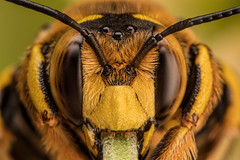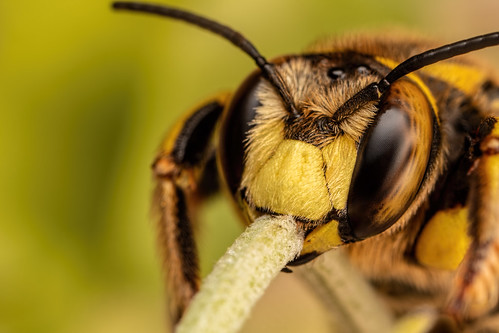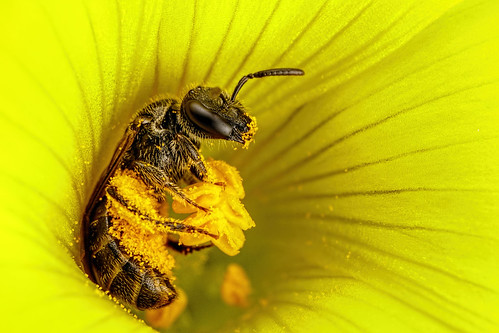Almost from the first day that crop factor sensors were introduced (sensors smaller than the 35mm standard 36mm x 24mm) people have tried to claim that they were somehow special, that their diminutive size granted them almost magical qualities. I've seen everything from "crop factor sensors give you more depth of field" to "the exposure changes cause smaller sensors gather less light". Both of those statements are so incredibly false it's not even funny, and the explanation is really simple: The crop that a smaller than full frame sensor creates is no different than cropping in post. No matter how you do it cropping an image won't change anything other than how large the subject appears in the frame. To wrap your head around why let's try a simple thought experiment...
Canon makes two full frame camera with a 50MP sensor, the 5DS and the 5DS R. If you crop an image in post, taken with either camera, to a 1.6x crop then you're left with roughly an 18MP image. Cropping that image in post won't change the exposure, or magnification, obviously. But what would happen if you taped off an area around the sensor so now it has a 1.6x crop size? Not much other than the subject would be larger in the frame, the same effect you'd get if you cropped the full frame image in post. The magnification won't change because cropping an image, either by using a smaller sensor or cropping in post, won't reveal more detail in the subject. Cropping simply creates an enlargement. The exposure won't change either, since the same amount of light is striking each photo cell. There would be no difference in masking off the sensor, or cropping in post. No magic...
When I read that the physical size of a sensor alone changes the exposure of a scene it really puzzled me as to why someone would make that claim. But if you take a look at what they're saying they treat the entire sensor as a single light capturing element, and that's just not how digital sensors work. Each pixel on a digital sensor is a single light capturing devise, and a pixel's ability to capture light depends on its size -the bigger the pixel the more light it can "absorb" over a given time span. So bigger pixels are more light sensitive than smaller pixels, that much is true. But if the pixel size is the same two sensors will be equally light sensitive irregardless of the overall size of the sensor, as long as the underlying electronics are the same. Put the same lens on both a full frame camera and a crop factor camera, point them at the same scene, and the intensity of the light that's striking the pixels on both sensors will be exactly the same. If there is any difference in the exposure it will be due to differences in pixel size, or in how the camera's electronics amplify the signals produced by the pixels. Don't believe me? Go back to Canon's 50MP full frame sensor and mask off an area around it so that it's now a 1.6x crop factor sensor and nothing changes other than how large the subject will look in the frame, because it's cropped. The same amount of light is striking each pixel, so there won't be any change in exposure just because you've masked part of it off. Keep in mind that the size of the image circle projected by the lens does not change no matter what camera you put it on...
Is there an advantage to shooting macro with a crop factor sensor? Yes, and one of them is the ability to make a subject look larger in the frame at lower magnifications than when shooting the same scene with a full frame sensor. Shooting at a lower magnification will give you more depth of field, and I think that was the start of the myth concerning crop factor sensors and depth. Crop factor sensors don't give you more depth of field, being able to shoot at lower magnifications does since depth is simply a function of magnification and Fstop. But then again you could always take a shot with a full frame sensor and simply crop the image down to a 1.6x size.
If you have anything to add, or want to call me out for this post, just leave me a comment. I had to turn post moderation on because I was getting too many invitations to watch someone diddle themselves. So when you post a comment and it doesn't immediately show up don't worry, I will approve it as soon as I get the notification email even if your comment is negative. I've never filtered out a negative comment, just do me a favor and be civilized. Until next time, happy shooting!
Footnote: Another term making the rounds is "print magnification" and people are using it to describe how a subject looks larger in print when taken with a crop factor camera. But it's just enlarging the subject by cropping the image -and again it's no different than cropping a full frame image in post. I hate the term "print magnification" because it implies that the subject has been magnified, and it has not...
Saturday, July 13, 2019
Monday, July 8, 2019
Current Macro Rig and Diffusers
Several people have asked me about my gear and diffusers, so I thought I'd shoot a quick video to show you what I'm using and talk about how I light my subjects. One of the things that I failed to mention in the video is that I tested several different diffusion plastics when I was trying to tame the hot spot that the MT-24EX macro twin flash creates in the specular highlights and multiple layers of 1/4 stop white silk was the only material I found that really worked well, and I use it in the diffuser that I built for the MT-26EX-RT. If forces the light to spread out while only reducing the light by 1/4 stop per later. I've also designed my diffusers to be small enough so that I can place the key at 12 O'clock (on a Kaiser Adjustable Flash Shoe) and the fill at 3 O'clock. Keeping them small also allows me to get them close to the subject without bumping into things. With all that being said here's the video:
When you're shooting you also need to be conscious of how the light is going to bounce off of the immediate surroundings and potentially change color. This shot was taken at my patio table, the same white plastic one in the video. By keeping the subject close to the table I'm able to use it like a bounce card to keep from crushing the shadows, and because it's white there's no change to the white balance of the light:
Here's another European Wool Carder Bee, only this one was shot while sitting on a yellow flower. Notice the warmer tones due to the shift in white balance:
The shadows are even lighter in that shot since the subject is closer to the "bounce card". I rarely change the white balance in post, preferring to allow the light to change based on what it reflected off of because it keeps my light from looking exactly the same all the time. Here's an extreme example of how the light can change after bouncing off of an object and back to the subject. The flower was a mix of oranges and reds, and notice how the specular highlights in this Long Horned Beetle took on the color:
I don't mind how the light changed, in fact I kinda like it. But as you work on your lighting you need to understand how the surroundings can change the quality of it. The diffuser isn't the only thing that's modifying the light from your flash. Even the artificial flowers that I use for the background in a lot of my images can effect the white balance, and in turn change the tone of the light and how the colors are rendered.
Last, but not least, I'd like to mention that the angle of the light can also make a difference in the detail that you pick up and how 3D a scene will look. I like shooting Sweat Bees in Sour Grass Flowers while they are foraging for pollen because it's tricky, and because it makes for a more interesting photo than shooting them when they are lethargic. This first shot is with both flash heads on the Canon MT-24EX flash mount:
Same species, same type of flower, and about the same magnification but this time the key (the "A" flash head) is on a Kaiser Adjustable Flash Shoe and it's firing at a low angle with respect to the flower. Notice how there's more texture in the flower and the subject:
So not only will using a more diffused light source give you more detail, but the angle of the light also makes a difference.
If you have any questions just drop me a comment here, or on the Extreme Macro Facebook page. Until next time happy shooting :)
When you're shooting you also need to be conscious of how the light is going to bounce off of the immediate surroundings and potentially change color. This shot was taken at my patio table, the same white plastic one in the video. By keeping the subject close to the table I'm able to use it like a bounce card to keep from crushing the shadows, and because it's white there's no change to the white balance of the light:
Here's another European Wool Carder Bee, only this one was shot while sitting on a yellow flower. Notice the warmer tones due to the shift in white balance:
The shadows are even lighter in that shot since the subject is closer to the "bounce card". I rarely change the white balance in post, preferring to allow the light to change based on what it reflected off of because it keeps my light from looking exactly the same all the time. Here's an extreme example of how the light can change after bouncing off of an object and back to the subject. The flower was a mix of oranges and reds, and notice how the specular highlights in this Long Horned Beetle took on the color:
I don't mind how the light changed, in fact I kinda like it. But as you work on your lighting you need to understand how the surroundings can change the quality of it. The diffuser isn't the only thing that's modifying the light from your flash. Even the artificial flowers that I use for the background in a lot of my images can effect the white balance, and in turn change the tone of the light and how the colors are rendered.
Last, but not least, I'd like to mention that the angle of the light can also make a difference in the detail that you pick up and how 3D a scene will look. I like shooting Sweat Bees in Sour Grass Flowers while they are foraging for pollen because it's tricky, and because it makes for a more interesting photo than shooting them when they are lethargic. This first shot is with both flash heads on the Canon MT-24EX flash mount:
Same species, same type of flower, and about the same magnification but this time the key (the "A" flash head) is on a Kaiser Adjustable Flash Shoe and it's firing at a low angle with respect to the flower. Notice how there's more texture in the flower and the subject:
So not only will using a more diffused light source give you more detail, but the angle of the light also makes a difference.
If you have any questions just drop me a comment here, or on the Extreme Macro Facebook page. Until next time happy shooting :)
Subscribe to:
Posts (Atom)







